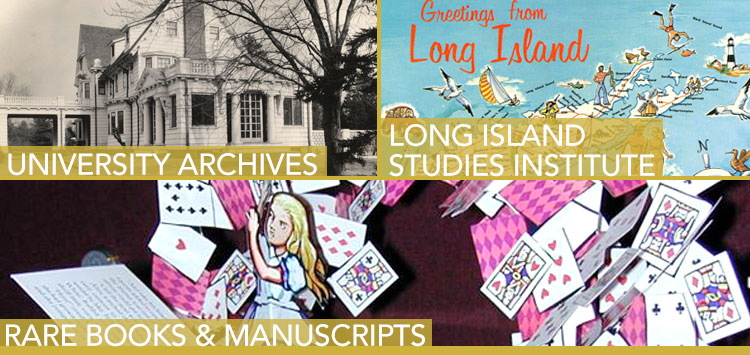| Collection Finding Aid | Access the Digital Photos|
Introduction to the Collection
On September 11, 2001, terrorists attacked the United States by hijacking planes and crashing them into the World Trade Center and the Pentagon. A fourth plane was hijacked, but its passengers revolted before it crashed in Pennsylvania and reached its target.
Many Long Island residents worked in the World Trade Center's Twin Towers and the surrounding area known as the Financial District. Some of the New York City firefighters and New York City police officers who rushed to the scene were from Long Island. After the tragedy, the Long Island residents who worked as firefighters, police officers, and MTA and construction workers went back to downtown Manhattan day after day to sift through the rubble. The personal accounts of some of these workers are a unique part of our collection.
Individuals, members of trade unions, and government agencies as well as health care workers from Long Island rushed to the aid of the wounded city. This collection records their actions with documents, photos, and personal accounts.
Recovery workers from the suburbs would return home every night only to return to the city in the morning to continue cleaning up the aftermath. Businesses on the Island donated money and supplies to the relief effort and to charities that helped the victims' families. This collection holds documentation of the efforts of these rescue and recovery workers, and of businesses. However, it was not only the rescue and recovery workers who dedicated themselves to helping New York City, elementary school students held fundraisers for the relief funds and sent cards and letters of encouragement to the workers in lower Manhattan. Their stories can be found in this collection as well.
All over Long Island memorial services were held for those whose lives were lost on September 11. Lists of the missing and lost are included in the collection along with highlighted names of Long Island residents. Religious institutions worked overtime to plan funerals and to provide counseling and community outreach to all of the people who experienced different degrees of sadness, fear, and confusion. The community services of religious institutions are documented herein as well.
Similarly, parents and teachers helped children to understand what had happened. Methods of consolation used by the adults and the words and images of the children of Long Island are included in this collection. Even the entertainment industry was touched by these events, as is evident in the contents of the sports folders and the newspaper comic pages in the days, weeks, and months after September 11.
The correspondence and published writings included in the September 11th Project Collection reflect the thoughts of Long Island residents as they contemplated the terrorist attacks on the United States and the subsequent war on terrorism.
Nonprofit organizations such as libraries, museums, and historical societies attempted to collect and disseminate information. They were instrumental in putting events in context for people who sought and continue to seek a better understanding of how the nation and world changed as a result of the attacks.
In local, regional, and national publications, journalists tried to keep up with a world that had been changed in an instant and has continued to change. Visual artists, poets and photographers tried to capture the many experiences and emotions that ran through the people of Long Island, New York, and the nation.
The collection includes artifacts such as hard hats, gloves, respirators, boots, a pickax, and a hoe used by Long Island residents who worked in the recovery effort on the 11th and in the days and weeks following the attacks. Also included is one of the banners that hung at the WTC site to encourage the rescue/recovery workers, which is emblazoned with the word "TEAMWORK" and a biblical quote.
The Long Island Studies Institute September 11th Project Collection contains materials that show how the terrorist attack on the World Trade Center affected the people of Long Island. Development of the collection is ongoing and has been used by researchers since its creation.
Collection Documents and Artifacts
The September 11th Project Collection contains documents and artifacts from the following areas or groups:
- Arts
- Business and Corporate Documents
- Educational Institutions, including Hofstra University
- Government Agencies
- Health Care Industry
- Lists of Missing and Lost
- Memorial Events and Services
- Nonprofit Organizations
- Personal Accounts
- Photos
- Publications
- Books
- Magazine
- Newspapers
- Religious Institutions
- Sports
- Unions
- Web Sites
- Restricted Files
- Audio Cassettes
- Video Cassettes
- Project Artifacts
 Rescue Workers at the World Trade Center site.
Rescue Workers at the World Trade Center site. Students and a teacher placing ribbons on trees at Harold D. Fayette Elementary School in North Merrick, UFSD
Students and a teacher placing ribbons on trees at Harold D. Fayette Elementary School in North Merrick, UFSD Letter written and addressed to God asking for peace for our nation.
Letter written and addressed to God asking for peace for our nation. Digital Art by Susan Oakes (SuOakes Graphic Design) 'September 11, 2001: No Time to Scream'
Digital Art by Susan Oakes (SuOakes Graphic Design) 'September 11, 2001: No Time to Scream' Digital Art by Susan Oakes (SuOakes Graphic Design) 'September 11, 2001: Untimely Death'
Digital Art by Susan Oakes (SuOakes Graphic Design) 'September 11, 2001: Untimely Death'


